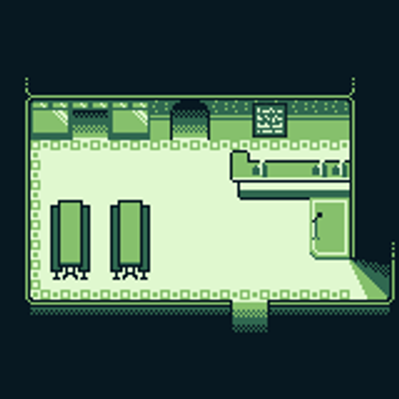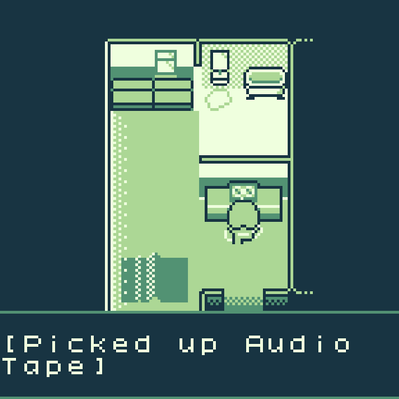A port of ZA/UM’s 2019 RPG Disco Elysium to Nintendo’s 1990 Game Boy handheld while maintaining the core mechanics of the original.
Adapting the entirety of Disco Elysium was a bit out of the project scope, but a vertical slice of the game would be perfect. Disco’s mechanics are easily communicated and the world is a single neighborhood. Functionally it might have more in common with point-and-click adventure games, featuring no combat and an eclectic series of items to collect. The skill check system takes a page from tabletop games by relying on a roll of two D6 dice plus the character's stat, and writing interesting bespoke outcomes for the possible outcomes.
The project really came about while looking for something to create with GB Studio, a development tool for Game Boy. Notably, GB Studio constricts projects to what would actually be achievable on the Game Boy, and even allows projects exported as a ROM to run on real hardware. The tool is designed for the creation of RPG/Adventure games, but still features some key limitations.
- A scene is limited by the size of it’s background art, which are limited to 256 x 256 pixels.
- There is a maximum of 9 actors in the scene, plus the player. Actors are 16 x 16 pixels in size.
- Each scene can only contain a maximum of 25 sprites, shared by the player and the actors.
- There is a limited palette of 4 colours, and actors only have access to 3 of them to allow for transparency.
- Dialogue boxes are 18 characters wide and a maximum of 3 lines, or only 16 with a character portrait.
Quests
Limiting the available area in the game also limits the quests available, as many involve traveling to multiple locations. As such, I selected a few of the most memorable events in the available space and integrated them into one central quest, and a few side objectives to recreate iconic moments.
Interface & Menus
GB Studio features minimal UI support, but one of my objectives of this project was to translate a modern UI to the Game Boy format. To overcome this, each information-heavy UI screen was created a scene, with the player's character as a cursor. Disco Elysium’s UI features a highly tactile style, with most items sliding on-screen as some kind of data-tape. I took these elements as the inspiration for my adapted UI, and tried to give each unique screen the feel of early graphical interfaces. Elements from Disco Elysium’s UI which didn’t make the cut are incorporated as visual flavour, like the “Officer Profile” and over-head view of the player.
Connections between the menu scenes in GB Studio. Each transition between buttons & scenes had to be scripted manually.
Skills
The simple solution here was to condense Disco’s 24 skills into their 4 categories; Psyche, Intellect, Physique and Motorics. The demake would feature less than 24 skill checks throughout, so there was no need for that many skills. This unfortunately lost much of the nuance of skills like “Shivers” being interpreted as a part of one’s body instead of mind. Because I wanted the game to be ~30 minutes instead of 15+ hours, I also miniaturized the skill system to be based around less points, but players would progress more often.
Leveling
Disco Elysium uses a tradition leveling system with experience being accrued, and new skill points assigned to any skill you like. A key caveat is the cap on how many points can be assigned to a skill, which can be increased through other means. The small amount of events in my project meant there wasn’t space for this level of elaborate character development. Instead, I automated leveling & development. Players are awarded +1 point in the relevant skill on a failed roll, and +1 cap of a success. The idea is to always reward the player for trying, and always have space for them to grow instead of snowballing success. Ideally, a player would ping-pong between successes and failures as the check difficulty increased through the game.
Ideas
The second type of character development in Disco is filling up your “Thought Cabinet”, a collection of beliefs and experiences which give your character unique dialogue options or mechanics. There are 53 in total, many of which are well outside of the slice of game I was adapting. I chose 4 "thoughts", and adapted them as "Ideas" players could unlock in my vertical slice. The art for the ideas are adapted from a massive illustration by Anton Vill in the original game.
Items
Items have been limited to consumables to give a temporary skill-boost, and the few key items required for the story. To keep under the sprite limitations, the item art is baked into the background, and then the count is layered on top. Unfortunately, the fantastic clothing system didn’t make the cut.
World & Backgrounds
An early choice was to only adapt the opening scenes of the game, pertaining to the Whirling-In-Rags hostel and it’s yard. GB Studio is designed to build a series of small, connected scenes instead of large maps, making it perfect for a game taking place primarily inside one building. These are also some of the most iconic locations in the game, and would serve as the framework for scoping the rest of the project.
Portraits
Aleksander Rostov’s distinctive painterly illustrations don’t easily adjust to Game Boy resolution, and I had to sacrifice some details to keep the characters recognizable.
































